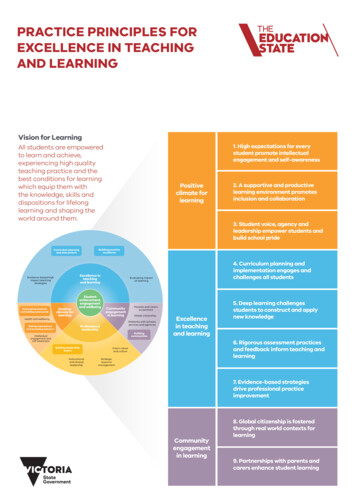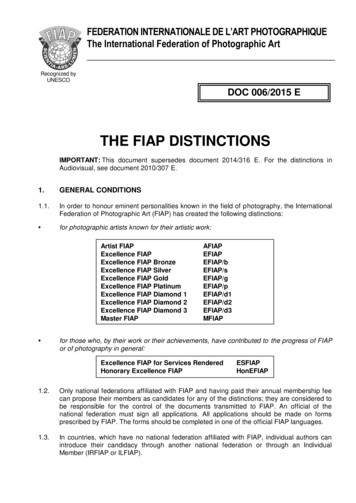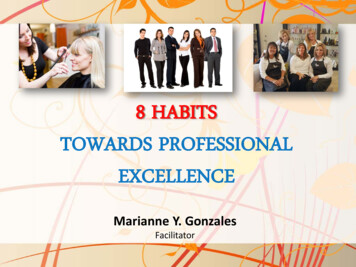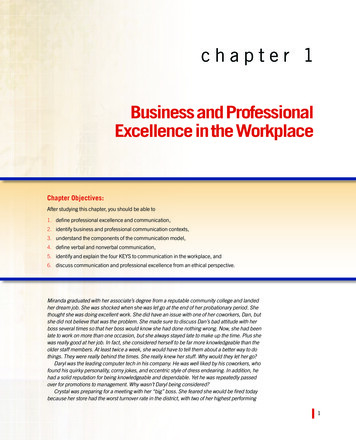
Transcription
PRACTICE PRINCIPLES FOREXCELLENCE IN TEACHINGAND LEARNINGVision for Learning1. High expectations for everystudent promote intellectualengagement and self-awarenessAll students are empoweredto learn and achieve,experiencing high qualityteaching practice and thebest conditions for learningwhich equip them withthe knowledge, skills anddispositions for lifelonglearning and shaping theworld around them.3. Student voice, agency andleadership empower students andbuild school prideExcellence inteachingand learningEvidence-based highimpact teachingstrategiesPositiveclimate forlearningStudentachievement,engagementand wellbeingCommunityengagementin learningParents and carersas partnersGlobal citizenshipNetworks with schools,services and ntellectualengagement andself awarenessBuilding leadershipteamsInstructionaland sharedleadership4. Curriculum planning andimplementation engages andchallenges all studentsEvaluating impacton learningHealth and wellbeingSetting expectationsand promoting inclusion2. A supportive and productivelearning environment promotesinclusion and collaborationBuilding practiceexcellenceCurriculum planningand assessmentEmpowering studentsand building school pridePositiveclimate forlearningExcellencein teachingand learning5. Deep learning challengesstudents to construct and applynew knowledge6. Rigorous assessment practicesand feedback inform teaching andlearningVision valuesand cultureStrategicresourcemanagement7. Evidence-based strategiesdrive professional practiceimprovementCommunityengagementin learning8. Global citizenship is fosteredthrough real world contexts forlearning9. Partnerships with parents andcarers enhance student learning
First published by the Department of Education andTraining Melbourne February 2018, updated October 2020. State of Victoria (Department of Education andTraining) 2020The copyright in this document is owned by the State ofVictoria (Department of Education and Training), or in thecase of some materials, by third parties (third partymaterials). No part may be reproduced by any processexcept in accordance with the provisions of the CopyrightAct 1968, the National Education Access Licence forSchools (NEALS) (see below) or with permission.An educational institution situated in Australia whichis not conducted for profit, or a body responsiblefor administering such an institution may copy andcommunicate the materials, other than third partymaterials, for the educational purposes of the institution.Authorised by the Department of Education and Training,2 Treasury Place, East Melbourne, Victoria, 3002.ISBN: 978-0-7594-0827-22 Practice Principles for Excellence in Teaching and Learning
AcknowledgmentsThe Department of Education and Training (the Department)acknowledges and pays respects to Elders and all VictorianAboriginal communities. We honour and respect TraditionalOwners, past and present, and value the rich culture and historyof the First Peoples of this land.The Department also acknowledges the expertise andcommitment of teachers and school leaders in Victoriangovernment schools who work to build teaching and learningexcellence every day.For the preparation of this resource we would like to acknowledgethe advice and inspiration provided by Dr Julia Atkin, andvaluable contributions from many of our principals and teachers.The Practice Principles for Excellence in Teaching and Learning isa component of the Victorian Teaching and Learning Model.The Practice Principles draw from the current evidence base,including the following Victorian frameworks and initiatives: Australian Professional Standards for Teachers Education State reform agenda Framework for Improving Student Outcomes New Pedagogies for Deep Learning Community of Practice Professional Learning Communities School Differentiation Model (School Strategic Plan, AnnualImplementation Plan, Performance and DevelopmentApproach) Victorian Curriculum F-10 Victorian Early Years Learning and DevelopmentFramework.Practice Principles for Excellence in Teaching and Learning 3
ContentsAcknowledgments36Why a Vision for Learning and Practice Principles?7What is our Vision for Learning?8What are the Practice Principles?8Who are the Practice Principles for?10Practice Principles overview table121. High expectations for every student promote intellectualengagement and self-awareness142. A supportive and productive learning environment promotesinclusion and collaboration163. Student voice, agency and leadership empower studentsand build school pride184. Curriculum planning and implementation engagesand challenges all students205. Deep learning challenges students to construct and applynew knowledge226. Rigorous assessment practices and feedback inform teachingand learning247. Evidence-based strategies drive professional practiceimprovement268. Global citizenship is fostered through real world contextsfor learning289. Partnerships with parents and carers enhancestudent learning30Appendix 1 - Principles aligned with Victorian and nationalframeworks and initiatives32Practice Principles for Excellence in Teaching and Learning 5
Introduction‘It may seem obvious that getting to scale with powerful teaching and learning for all students requires having and sharing avision of what that should look like. If after all, you don’t agree on where you are trying to get, it is pretty challenging to get there.’ 1In Victoria we are committed to building a world classeducation system and transforming Victoria into theEducation State. This starts in the early years and relies onshared1 outcomes across sectors to support continuity oflearning. It is this commitment towards achieving increasedequity and excellence at a system level that frames our workas teachers and leaders, but we must draw our focus to whathappens in every classroom and in every school to make thedifference for all Victorian students.The Victorian Teaching and Learning Model comprises 4interrelated components through which excellence in teachingpractice is articulated: an overarching Vision for Learning,Practice Principles, for excellence in teaching and learning, thePedagogical Model which describes what effective teachinglooks like in the classroom and helps teachers apply thePractice Principles, and the High Impact Teaching Strategiesthat outline 10 instructional practices that reliably increasestudent learning.In our work as educators we must ask ourselves“how well are we achieving what we value and believe, andhow well does our current situation match our vision forlearning?”2 From this understanding emerges our sharedcommitment and actions to improve student learningoutcomes and teacher practice.The Practice Principles outlined in this resource providepowerful evidence-based support for teaching practice. Theydraw from a substantial knowledge base about the‘fundamentals’ that support and accelerate student learning,and, most importantly, they articulate a cohesive view ofeffective teaching and learning which integrates all the keyaspects of teaching, including curriculum, pedagogy andassessment. The Practice Principles provide Victorian schoolswith the means to effectively deliver the Victorian Curriculumand to measure impact on learning through rigorous andauthentic assessment.For teachers and school leaders, linkages between the PracticePrinciples and the Framework for Improving StudentOutcomes (FISO) will be clear. Focusing on three FISO priorityareas – Excellence in teaching and learning, Positive climatefor learning, and Community engagement in learning –teachers and school leaders can guide conversations withstudents, parents and school communities about our valuesand our beliefs about teaching and learning. Theseconversations will help to build consensus around our moralpurpose and mobilise partnerships in ways that improvelearning.Working with the Practice Principles will deepen theprofessional conversations taking place in Victoriangovernment schools, support the development of a sharedlanguage for teaching and learning and help us to articulatewhat teaching and learning excellence looks like. I encourageteachers and school leaders to draw on the Practice Principlesto support the growth and development journey which istaking place in every school.Working with the Practice Principles willdeepen the professional conversationstaking place in Victorian governmentschools, support the development of ashared language for teaching and learningand help us to articulate what teachingand learning excellence looks like.Teachers working in the early years of primary school will alsorefer to the Victorian Early Years Learning and DevelopmentFramework (VEYLDF) Practice Principles, bringing coherenceto our education system and ensuring continuity of learningacross education settings and developmental stages.City, EA, Elmore, RF, Fiarman, SE, Teitel, L (2009). Instructional rounds in education: a network approach to improving teaching and learning, HarvardEducation Press, Cambridge, Massachusetts, p. 173.2Atkin, J. (1996). Seminar Series. From Values and Beliefs about Learning to Principles and Practice, Jolimont, Australia: Incorporated Association of RegisteredTeachers of Victoria, p.5.16 Practice Principles for Excellence in Teaching and Learning
Why a Vision for Learningand Practice Principles?This resource introduces an ambitious Vision for Learning,and sets out clear and evidence-based Practice Principles forExcellence in Teaching and Learning.As indicated in the diagram below, teachers can anchor theirpractice in an articulated moral purpose and establish aholistic approach to teaching and learning drawing from:A Vision for Learning helps teachers and school leaders tocreate a unified set of values and beliefs which drive thedevelopment of a high performance learning culture. It isframed by these fundamental questions: the Vision for Learning which creates the foundation forsuccess and a narrative for change the Practice Principles for Excellence in Teaching andLearning, which unpack this Vision for Learning into a coherentdelineation of practice excellence a pedagogical model which provides a holistic view ofclassroom practice and a reference point for the cohesiveimplementation of the Practice Principles teaching strategies such as those outlined in the Literacy andNumeracy Strategy and the High Impact Teaching Strategies(HITS).Why are we here?What do we stand for?How do we achieve our goals?When teachers can identify the values and beliefs at the centreof their practice, they have a frame of reference that helpsthem to evaluate their current practice. Mindsets change whenteachers actively adjust their practice to ensure it is alignedwith their core values and beliefs.The Vision for Learning and the Practice Principles will helpteachers and school leaders to consider: what school communities and teachers value the beliefs about learning which underpin practice how current practice helps to achieve what is valued how new practices will help to achieve what we value.3PRACTICE PRINCIPLES FOR EXCELLENCE INTEACHING AND LEARNING CONSISTS OF: the Vision for Learning 9 Practice Principles for Teaching and Learning a set of Diagnostic Tools (available online only)Vision for LearningAll students are empowered tolearn and achieve, experiencinghigh quality teaching practice andthe best conditions for learningwhich equip them with theknowledge, skills and dispositionsfor lifelong learning and shapingthe world around them.Visionfor Strategies3Atkin, J. (1996). Seminar Series. From Values and Beliefs about Learning to Principles and Practice, Jolimont, Australia: Incorporated Association of RegisteredTeachers of Victoria, p.5.Practice Principles for Excellence in Teaching and Learning 7
What is our Visionfor Learning?What are the PracticePrinciples?‘All students are empowered to learn and achieve, toexperience high quality teaching practice and the bestconditions for learning which equip them with the knowledge,skills and dispositions for lifelong learning and to shape theworld around them.’The Practice Principles for Excellence in Teaching andLearning provide a foundation for the conversations,collaborations and actions at the centre of teaching andlearning. For most teachers the Practice Principles will bea familiar part of everyday practice, so the purpose of thisresource is to bring them together to guide teacher reflectionsand conversations about what they teach, the way they teach,and how they think about teaching. Early years teachers willalso draw on the VEYLDF Practice Principles for Children’sLearning and Development which provide an evidencedbased understanding of the science of early learning anddevelopment to guide teachers to know what children up toeight years of age need to thrive and the pedagogy that bestsupports this.In Victoria, our Vision for Learning articulates our aspirationsand beliefs about teaching and learning. With students atits centre, the Vision outlines our aspiration for all studentsto achieve and grow as learners, and to generate their owncourse for lifelong learning. Students will be empowered to takeownership of their learning, to make purposeful contributionsto their learning environments, and to tackle issues arising inthe world around them.The Vision for Learning also recognises the central role ofteachers as they use expert knowledge, skills and dispositionsas designers. They develop engaging and challenging learningprograms and create the optimal conditions for studentlearning, including supporting parents as first educators andpartners in education. Teachers model lifelong learning as theybuild reflection and deep levels of thinking into their practiceand challenge themselves and their students to co-constructand apply new knowledge.Victoria’s Vision for Learning creates the narrative for change,and draws our focus to the values and beliefs at the heartof teaching and learning. For teachers and school leaders inVictorian schools it provides a starting point for a close analysisof school culture and professional practice.THE PRACTICE PRINCIPLESThere is a substantial body of knowledge about effectiveinstructional practices and what works to improve studentlearning outcomes in schools. Drawing from this body ofresearch nine Practice Principles have been identified forthe Victorian context. These Practice Principles are signaturepedagogies which ‘make the difference’, and research hasexplicitly linked them to improved student achievement andmotivation.The Practice Principles articulate how teachers can deliverthe curriculum and engage students. They are designed tolink directly to a school’s documented teaching and learningprogram, which outlines what is to be taught, and theapproach to assessment, which helps teachers determinestudent learning needs and how students can demonstratetheir levels of understanding.Each Principle is supported by a theory of action that describeshow the work of teachers can generate improved studentlearning over time. It explains the specific changes that can beexpected and creates a brief evidence-based synopsis.ACTIONSEach of the Principles is unpacked into three or four key Actionswhich provide more detail about the specific teacher practiceswhich contribute to effective teaching and learning. Teacherswill be able to reflect on their practice, gather evidence abouttheir strengths and areas for improvement, and use the Actionsto draft Performance and Development Plans (PDPs) and planfor classroom practice improvement.8 Practice Principles for Excellence in Teaching and Learning
INDICATORSDIAGNOSTIC TOOLSThe Actions cascade into a set of Indicators which provideadditional, and more granular detail about the Principleand what it looks like in practice. The Indicators can be usedas a diagnostic tool for teacher self-reflection, for teacherobservation and feedback, and as the basis for studentfeedback to teachers.The Diagnostic Tools are designed to support collaborativepractice improvement. They will help school leadership teamsand teachers to: determine how effectively the Principles (one, several orall) are embedded in teacher practice across a school,in Professional Learning Communities, and in individualclasses identify focus areas for peer observation and feedback,learning walks, and PDP goals determine the ‘next step’ which will help ProfessionalLearning Communities and teachers to improve practice.ENGAGEMENT ACTIVITIESTwo engagement activities for each of the nine Principles willsupport teachers, individually and in teams, to develop, reflecton, and gather evidence of their practice. An engagementactivity is just that: something that prompts discussionand debate, and provides an exercise to use in classrooms,Professional Learning Communities or with students. Eachengagement activity includes a stimulus and set of questionsor tasks that, when applied, will deepen understanding ofthe Principle.Teachers should not feel constrained by the questions but usethem to promote rich conversations that challenge and extendprofessional thinking and practice. They can also be usedcollaboratively with students in the classroom, and form thebasis for reflection and evidence gathering for improvement.The diagnostic tools are available online from thePractice Principles page (see: ) on the on the Department’swebsite.Practice Principles for Excellence in Teaching and Learning 9
Who are the PracticePrinciples for?TEACHERSPROFESSIONAL LEARNING COMMUNITIESThis resource provides an opportunity for teachers toevaluate their practice with a focus on one or more ofthe Practice Principles and share reflections and newunderstandings about what works in classrooms withtheir colleagues. For teachers in the early years thesediscussions can also occur collaboratively with earlychildhood professionals using the VEYLDF PracticePrinciples to discuss evidence-based approaches to bestpractice.‘Collaboration is a powerful way to deepen educator capacity,to increase the total value of the professional capital in theschool, and to harness the power of the collective.’4All teachers will benefit from regularly engaging with thePractice Principles. Starting from the engagement activitiesand using the diagnostic tools, teachers can diagnoseareas requiring attention and set improvement goals thataddress both student and personal development needs.Teachers can document these goals in their PDPs, drawlinks to the Australian Professional Standards for Teachersand demonstrate progression toward the achievement oftheir goals.By using the Practice Principles in parallel with the FISOImprovement Cycle as part of collaborative professionallearning, teachers can maximise their impact on teacher andstudent learning. The Department’s best practice approachto collaborative professional learning is exemplified in theProfessional Learning Communities (PLC) initiative (to learnmore about the initiative see: www.education.vic.gov.au/plc)however teachers will already be familiar with the process ofworking in professional learning teams. Effective teams will: collect evidence to gauge teaching and learningeffectiveness identify a problem of practice engage with the resource to discuss strategies review teaching practice through observation andfeedback.High quality teaching and learning is deliberate work.Purposeful engagement with the Practice Principles incollaborative teams will help all teachers to develop new skillsand strategies, and build student motivation and commitmentto improve their own learning.FOCUS AREAS FOR USING THE FISO IMPROVEMENT CYCLE TO SUPPORT TEACHING AND LEARNINGEvaluateand diagnose4Prioritiseand set goals What’s going on forour learners? What does ourevidence tell us? How do we know? Where will weconcentrate ourenergies to make thegreatest impact onlearning? How will we measureimpact?Developand plan How will we targetour teaching toensure we aremeeting all studentswhere they are ATand support wherethey need to goNEXT? What will we dothat will have thegreatest impact onstudent learning? What is currentlyworking, what needsto change and howwill we find outmore?Implementand monitor How will we knowalong the way thatour efforts aremaking enoughof a difference onstudent progress?Sharratt, L. & Plance, B. (2016). Leading Collaborative Learning: Empowering Excellence. Thousand Oaks, California: Corwin.10 Practice Principles for Excellence in Teaching and Learning
SCHOOL LEADERSFor school leaders the Vision for Learning and the PracticePrinciples provide an opportunity to bring coherence to wholeschool improvement efforts.The Vision for Learning and the Practice Principleswill support school improvement across the eightFISO Essential Elements for School Improvement:The Key Improvement Strategies and Actions documentedin school Annual Implementation Plans will become moremeaningful to teachers as they set PDP goals and use thePractice Principles to contribute to achieving improvementtargets.1.In addition, school leaders will be able to address four keyleadership dimensions in the FISO Professional LeadershipPriority using the Practice Principles:3. School improvement team formed to develop,oversee and evaluate the effectiveness andimpact of the Annual Implementation Plan Vision, values and culture – where leaders promote afuture focussed vision, a common purpose and values,and the commitment of teachers, parents and students torealise the potential of all students Building leadership teams - that empower and developtheir staff, collectively and individually, at their point ofneed4. Student voice, leadership and agency in ownlearning activated so that students have positiveschool experiences and can act as partners inschool improvement Instructional and shared leadership – where leadersare actively involved in discussions with teachers aboutinstructional matters, including how instruction impacts onstudent achievement6. Moderation of common student assessment tasksStrategic resource management – where leaders areequipped to determine what teaching expertise andresources are needed to achieve student learning goalsand source and allocate them accordingly.8. Explicit use of evidenced-based schoolimprovement strategies and teacher professionalpractice activities. Documented curriculum plan, assessment andshared pedagogical approaches2. School-based professional learning programdeveloped and implemented that supports theschool’s identified improvement strategies5. Whole school approach to health, wellbeing,inclusion and engagement7. Data collection, analysis and evaluation ofstudent learning growth over timeFor more information on the FISO Essentialelements The Department welcomes questions, comments and feedback on the Practice Principles. Your engagement andcontribution will contribute to the ongoing development and improvement of our resources, including future versions ofthis publication. To contact the Department with regard to Practice Principles, contact: professional. practice@edumail.vic.gov.auPractice Principles for Excellence in Teaching and Learning 11
Practice Principles overview tableVision for LearningAll students are empowered to learnand achieve, experiencing highquality teaching practice and the bestconditions for learning which equipthem with the knowledge, skills anddispositions for lifelong learning andshaping the world around them.1. High expectations forevery student promoteintellectual engagementand self-awarenessPositiveclimate forlearning2. A supportive and productivelearning environmentpromotes inclusion andcollaboration3. Student voice, agency andleadership empower studentsand build school prideBuilding practiceexcellenceCurriculum planningand assessmentExcellence inteachingand learningEvidence-based highimpact teachingstrategiesEmpowering studentsand building school pridePositiveclimate forlearningStudentachievement,engagementand wellbeingEvaluating impacton learningCommunityengagementin learningHealth and wellbeingGlobal nt andself awarenessBuilding leadershipteamsInstructionaland sharedleadership5. Deep learning challengesstudents to construct andapply new knowledgeParents and carersas partnersNetworks with schools,services and agenciesProfessionalleadershipSetting expectationsand promoting inclusion4. Curriculum planning andimplementation engagesand challenges all studentsExcellencein teachingand learningVision valuesand cultureStrategicresourcemanagement7. Evidence-basedstrategies driveprofessional practiceimprovementCommunityengagementin learning12 Practice Principles for Excellence in Teaching and Learning6. Rigorous assessmentpractices and feedbackinform teaching andlearning8. Global citizenshipis fostered throughreal world contexts forlearning9. Partnerships withparents and carersenhance student learning
Action 1.1Teachers convey highexpectations of learning,effort and engagementfor all studentsAction 1.2Teachers co-designaspirational goals withstudentsAction 1.3Teachers scaffold anddifferentiate learning toenable students to achievetheir goalsAction 1.4Teachers build studentcapacity to monitor andevaluate their own progressand achievementAction 2.1Teachers build qualityrelationships thatenhance studentengagement, selfconfidence and growthas a learnerAction 2.2Teachers ensure all students’cultural backgrounds, needsand abilities are recognisedand addressed in the learningprogramAction 2.3Teachers develop studentcapacity to collaborateAction 2.4Teachers maintain anenergised and focusedlearning environmentAction 3.1Teachers empowerstudents to have ademocratic voice inthe running of thecommunities in whichthey learnAction 3.2Teachers co-designopportunities for students toexercise authentic agency intheir own learningAction 3.3Teachers co-designleadership opportunitiesAction 4.1Teachers place studentneeds at the centre ofprogram planning anddeliveryAction 4.2Teachers collaboratively designand implement a scope andsequence of learningAction 4.3Teachers regularly review andupdate learning programs inline with school curriculumplansAction 5.1Teachers design learningprograms to explicitlybuild deep levels ofthinking and applicationAction 5.2Teachers support studentsto explore the construction ofknowledgeAction 5.3Teachers support students tobe reflective, questioning andself-monitoring learnersAction 6.1Teachers designauthentic, fit for purposeassessments to reflectthe learning programand objectivesAction 6.2Teachers use assessmentdata to diagnose studentlearning needs and plan forlearningAction 6.3Teachers provide regularfeedback to students on theirprogress against individuallearning goals and curriculumstandardsAction 6.4Teachers analyse studentachievement data to improvetheir practice24Action 7.1Teachers evaluate theimpact of teaching onlearning by analysingmultiple sources of dataAction 7.2Teachers identify and targetareas for professionallearningAction 7.3Teachers draw on currentresearch and use an inquiryimprovement cycleAction 7.4Teachers challenge andsupport each other toimprove practice26Action 8.1Teachers supportstudents to explore theirrole as global citizensAction 8.2Teachers model and facilitateuse of digital tools andresources to access, use andshare learningAction 8.3Teachers and students codesign learning that connectsto real world contextsAction 8.4Teachers and studentscollaborate in learningpartnerships in and beyondthe schoolAction 9.1Teachers establishopen and sustainedcommunications withparents/carersAction 9.2Teachers seek and useparents’/carers’ knowledgeand feedbackAction 9.3Teachers facilitate parent/carer involvement ineducation within theclassroom, school andbeyond1416Action 3.4Teachers build school prideand connectedness1820222830Practice Principles for Excellence in Teaching and Learning 13
Positive climate for learning1. High expectations for every studentpromote intellectual engagementand self-awarenessTheory of actionWhen teachers model and sustain high expectations as part of their regular classroompractice, students’ intrinsic motivation to achieve is lifted and outcomes improve.Actions and IndicatorsAction 1.1Action 1.3Teachers convey high expectations of learning, effort andengagement for all studentsTeachers scaffold and differentiate learning to enablestudents to achieve their goalsThis is evident when the teacher:This is evident when the teacher: communicates high expectations about all aspects of school emphasises the quality of learning with the valuing of effortdetermines prior knowledge to understand students’interests, aspirations and readiness for learning ensures all students understand the standards expected ofthem provides constructive feedback and challenges students tofurther their learning.uses a range of teaching strategies that leverage anddevelop different skills and abilities to enable achievementof goals empowers students to make decisions about what and howthey learn structures learning to support students to achievechallenging goals.Action 1.2Action 1.4Teachers co-design aspirational goals with studentsThis is evident when the teacher:Teachers build student capacity to monitor and evaluatetheir own progress and achievement builds students’ confidence, optimism and self-beliefThis is evident when the teacher: supports students to identify strengths and areas forimprovement ensures assessment criteria are explicit supports specific groups of students (e.g. English as anadditional language, disabilities and additional needs) withappropriate resources to tailor support and modify learninggoalsprovides a range of strategies, tools and rubrics to supportstudent self-evaluation and self-assessment assists students to frame future learning goals based onstrengths and ar
Practice Principles, for excellence in teaching and learning, the Pedagogical Model which describes what effective teaching looks like in the classroom and helps teachers apply the Practice Principles, and the High Impact Teaching Strategies that outline 10 instruc










